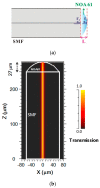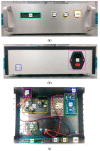Design and Implementation of a Novel Measuring Scheme for Fiber Interferometer Based Sensors
- PMID: 31546580
- PMCID: PMC6806084
- DOI: 10.3390/s19194080
Design and Implementation of a Novel Measuring Scheme for Fiber Interferometer Based Sensors
Abstract
This paper presents a novel measuring scheme for fiber interferometer (FI) based sensors. With the advantages of being small sizes, having high sensitivity, a simple structure, good durability, being easy to integrate fiber optic communication and having immunity to electromagnetic interference (EMI), FI based sensing devices are suitable for monitoring remote system states or variations in physical parameters. However, the sensing mechanism for the interference spectrum shift of FI based sensors requires expensive equipment, such as a broadband light source (BLS) and an optical spectrum analyzer (OSA). This has strongly handicapped their wide application in practice. To solve this problem, we have, for the first time, proposed a smart measuring scheme, in which a commercial laser diode (LD) and a photodetector (PD) are used to detect the equivalent changes of optical power corresponding to the variation in measuring parameters, and a signal processing system is used to analyze the optical power changes and to determine the spectrum shifts. To demonstrate the proposed scheme, a sensing device on polymer microcavity fiber Fizeau interferometer (PMCFFI) is taken as an example for constructing a measuring system capable of long-distance monitoring of the temperature and relative humidity. In this paper, theoretical analysis and fundamental tests have been carried out. Typical results are presented to verify the feasibility and effectiveness of the proposed measuring scheme, smartly converting the interference spectrum shifts of an FI sensing device into the corresponding variations of voltage signals. With many attractive features, e.g., simplicity, low cost, and reliable remote-monitoring, the proposed scheme is very suitable for practical applications.
Keywords: fast measurement scheme; fiber interferometer; optical fiber sensor.
Conflict of interest statement
The authors declare no conflict of interest.
Figures












References
-
- Lee C.-L., Lee C.-F., Li C.-M., Chiang T.-C., Hsiao Y.-L. Directional anemometer based on an anisotropic flat-clad tapered fiber Michelson interferometer. Appl. Phys. Lett. 2012;101:23502. doi: 10.1063/1.4734501. - DOI
-
- Zhang X., Bai H., Pan H., Wang J., Yan M., Xiao H., Wang T. In-Line Fiber Michelson Interferometer for Enhancing the Q Factor of Cone-Shaped In wall Capillary Coupled Resonators. IEEE Photon. J. 2018;10:6801808.
Grants and funding
LinkOut - more resources
Full Text Sources
Research Materials

